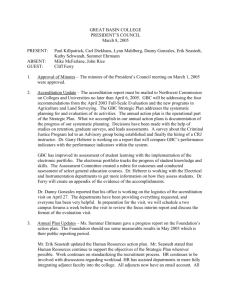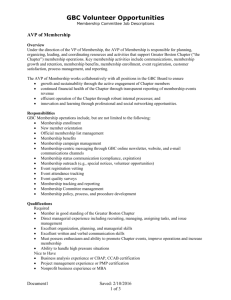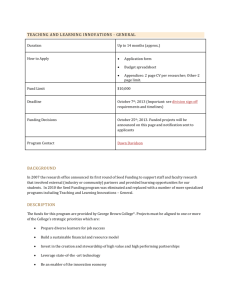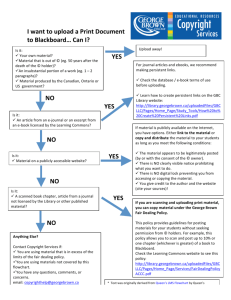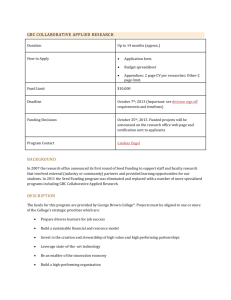John A. Lupienski
advertisement
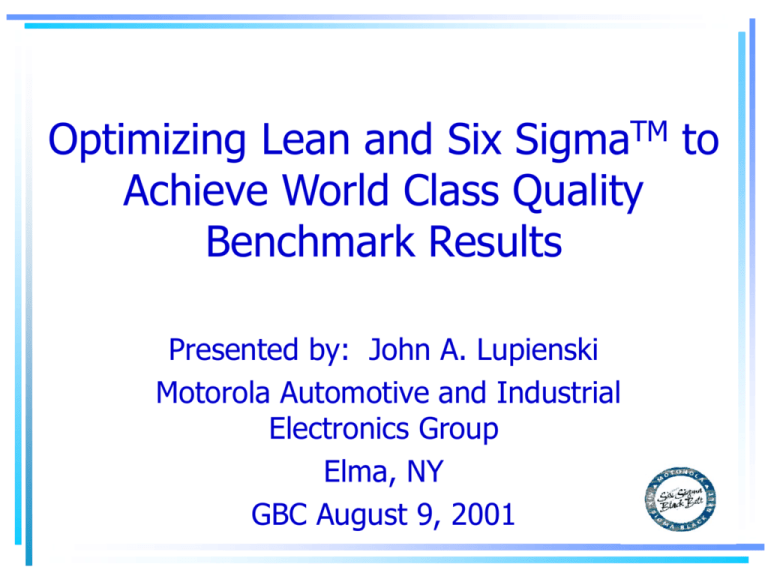
Optimizing Lean and Six SigmaTM to Achieve World Class Quality Benchmark Results Presented by: John A. Lupienski Motorola Automotive and Industrial Electronics Group Elma, NY GBC August 9, 2001 You will learn the process Motorola used to achieve these results!! 2000 ~18 Billion Internal and External 5.7+ Products Manufactured 1986 3.8 John Lupienski GBC Aug. 9, 2001 What We Will Cover • Understand the Culture Change needed to breakthrough to next 6 levels for Quality Improvement • Learn the 3 Key Focus Areas/Concepts with Lean / 6 – Black Belts roles? – What Sigma Level are you? • What are 6 Steps in achieving 6 and 5s of Lean Enterprise – 6 Hierarchy to breaking through to next levels – “RSM” (one tool) to help optimize Design for Manufacturability • How to Keep the Momentum Going – – – – Bottom Line Results!!! Motorola Scorecard- track results Benchmarking your company Lessons Learned • Questions and Answers John Lupienski GBC Aug. 9, 2001 We Must First understand Nature of Culture • Culture provides its members with guidelines for dealing with just about everything. • Much of every culture is covert and implicit — largely submerged like an iceberg. • Cultures are constantly changing and evolving. • When culture and strategy clash, culture invariably wins out. • If the organizational culture does not embrace initiatives related to change, overall change efforts will fail. John Lupienski GBC Aug. 9, 2001 Requirements for Cultural Change • Top-down commitment and involvement – Set the example; be active in the process • Measurement system to track progress – At both the macro and micro levels • Common, well-understood set of metrics – Set tough goals (Reach out!!!) – Benchmark best in class; audit often • Spread success stories – You can’t over-communicate • Train and education your people – Tell employees “why” and then show them “how” then get out of the way – Be willing to change your Paradigm!! John Lupienski GBC Aug. 9, 2001 Change the Old Quality Paradigm Cost Defects Defects 0 0 John Lupienski GBC Aug. 9, 2001 Set a New Quality Paradigm The Highest Quality Supplier will be the Lowest Cost Supplier! Defects Defects 0 Cost 0 John Lupienski GBC Aug. 9, 2001 To achieve LEAN/6 in a company, you must have clear insight of three key concepts: John Lupienski GBC Aug. 9, 2001 1. What is Six SigmaTM? Answer: It’s a Problem Solving Methodology that is Strategically aligned with the Companies objectives to improve the Bottom line while satisfying your “Customer” with less than 3.4 ppm Quality level. Remember: Both end user who buys it and each next step in the internal Business Process is a customer which includes the stakeholders. John Lupienski GBC Aug. 9, 2001 2. Who Makes Six Sigma / Lean? Answer: People (Mgt) determine what is needed, establish the priorities/projects, design & develop the specs./ layouts, buy equipment & assemble parts, generate the s/w to run the equipment and ship the products to your customers. It is not… robots, computers, machines or a spectator sport for Management. John Lupienski GBC Aug. 9, 2001 3. Why we have Quality Problems ? Quality problems reflect either changes in variations or “day one deviations” in the Business Process. Consistency is key. Q.P. = 40/30/30 Rule OR D/P/S Rule Answer: Get the Design, Process, Supplier people together early in Design process minimizes all problems. John Lupienski GBC Aug. 9, 2001 COMPARE A LEAN/6 COMPANY TO A TRADITIONAL COMPANY Outstanding LEAN / 6 Company Typical Traditional Company Driven by customer needs Prevention of problems before they happen “ day one problems” Nothing less than 100% will do Committed to quality at the source Cooperative, interdepartmental teams High Employee participation – empowered work force Long-term staying power is a primary goal Driven by company wants Detection of problems after the fact Established maximum acceptable levels of error, waste Believes inspection is the key to quality Autonomous, independent departments Top-down management-directed work force Short-term profit is a primary goal John Lupienski GBC Aug. 9, 2001 Success in LEAN/ 6 Requires Focus in Three Key Areas of a Company: Management Technology People John Lupienski GBC Aug. 9, 2001 Engineering M F G Administrative Management Objective in LEAN / 6 To ensure each stage of the “Business Process” is linked to next “Customer”. • This includes the Engineering, Finance, Manufacturing, Administration, and the General Public. • It takes a leadership team to oversee and guide the process & be accountable for its success. It takes more than one initiative. See Motorola key initiatives. John Lupienski GBC Aug. 9, 2001 1987 - The Motorola Card- distributed by the CEO Office emphasized key initiative 6 & Lean ( Cycle Time ) OUR FUNDAMENTAL OBJECTIVE (Everyone's Overriding Responsibility) Total Customer Satisfaction KEY BELIEFS -how we will always act - Constant Respect for People - Uncompromising Integrity KEY GOALS - what we must accomplish - Best In Class - People - Marketing - Technology - Product: Software, Hardware and Systems - Manufacturing - Service - Increased Global Market Share - Superior Financial Results KEY INITIATIVES - Six Sigma Quality - Total Cycle Time Reduction - Product, Manufacturing and Environmental Leadership - Profit Improvement - Empowerment for all, in a Participative, Cooperative and Creative Workplace John Lupienski GBC Aug. 9, 2001 Motorola Established a Quality, Cycle Time & Cost Benchmark • 1987 Corporation adopts Six SigmaTM by 1992 goal Quality 2 Year 10x = 68% year Cycle Time 5 Year 10x = 38% year Cost of Non Conformance < 1 % sales John Lupienski GBC Aug. 9, 2001 Motorola established a Quality Benchmark Six Sigma Improvement: over 100X 66810 ppm Defects per Million Opportunities 100K 3 10K 10X Improvement 4 1K 6210 ppm 30X Improvement 233 ppm 5 100 70X Improvement 10 3.4 ppm 6 1 2 3 4 5 Sigma 6 7 (with +/- sigma shift) John Lupienski GBC Aug. 9, 2001 Benchmarking for Quality Costs Benchmarking as % sales Defects per Million Opportunities 100K > 20% 10K Average Company Internal + External Quality Costs 1K 100 >> 100 X 10 <1% Best in Class 1 2 3 4 5 6 7 Sigma John Lupienski GBC Aug. 9, 2001 Technology Objective in LEAN / 6 To reduce process variability throughout the entire Business Process to achieve a perfect product – 100% Yield or defectfree on time with req’d. quantity. John Lupienski GBC Aug. 9, 2001 Continuous Improvement 6 To truly gain a competitive edge, a company must create a LEAN / 6 culture with continuous improvement throughout the entire Business Process, and not just work on technology leaps. John Lupienski GBC Aug. 9, 2001 LEAN/ 6 People Objective in LEAN / 6 To develop total employee involvement to continuously improve the product or process you are working on. “Education and Training” are essential. • Six Sigma Black Belts help to implement and deploy the process. John Lupienski GBC Aug. 9, 2001 Six Sigma Black Belt Deployment Routine and effective use of Six Sigma tools: to improve quality and new technology launches to reduce cycle time and costs John Lupienski GBC Aug. 9, 2001 A Black Belt will be…. • An “informal leader” from any Technical Discipline with strong advanced Statistical, Quality and Interpersonal Skills • Excellent communicator – Change Agent • An experienced and proven Problem Solving Leader in the use of Six Sigma Tools and Strategies with a continuous learning aptitude • Coach and Mentor using the continuous improvement model: MAIC - measure, analyze, improve and control John Lupienski GBC Aug. 9, 2001 Black Belts: Use MAIC Continuous Improvement Model “Peel the Onion” SUPPLIER • Process step 1 RECORD DEFECTS • Process step 2 RECORD DEFECTS • Process step 3 RECORD DEFECTS • CUSTOMER RECORD DEFECTS • RECORD DEFECTS TREND CHART PROCEDURE GOAL TIME MEASURE CONTROL AND INSTITUTIONALIZE ANALYZE PROBLEM SOLVE ACTION PLAN Action Name BRAINSTORMING/ PARETO ANALYSIS/ ROOT CAUSE IDENTIFICATION & IMPROVE Date 100% MOTOROLA’s© CONTINUOUS IMPROVEMENT MODEL John Lupienski GBC Aug. 9, 2001 Practical Solution Statistical Statistical Solution Problem Significant Problem The Six SigmaTM Methodology Prioritize opportunities for improvement Select team Measure Describe the total process Assess measurement system capability Measuring system capable? Analyze Improve measurement system Confirm significant characteristics Determine process capability Cp, Cpk meet goal? Improve Implement and/or enhance process control Is process stable Control Optimize the process Investigate to remove assignable causes Cp, Cpk meet next goal? Continue to monitor John Lupienski GBC Aug. 9, 2001 The Six Sigma Black Belt Program Core Skills Problem Solving Quality Tools Basic Statistics Interpersonal Skills Change Management Effective Presentations Consulting/Teamwork Business Skills Project Management Teaching/Coaching Skill Development 160 hrs. minimum Technical Skills Nonparametric Statistics Measurement System Analysis Design & Analysis of Experiments Robust Design / Tolerancing Reliability & Availability Data Analysis Techniques Survey Design & Analysis Multivariate Methods Advanced Regression Modeling Response Surface Methods Time Series / Forecasting Methods Benchmarking Techniques John Lupienski GBC Aug. 9, 2001 Six SigmaTM Black Belt Mentor Elma, NY. Structure Belt Sponsorship Related Projects Master Black 5 Black Belts 10 / Year Black 2 Green Belts 4 / Year Green Find 1 new Green Belt 2 / Year Institutionalization!! John Lupienski GBC Aug. 9, 2001 Black Belt Institutionalized • Green Belt – Data Gather and use basic problem solving tools – 10%-15% of Time spent problem solving – Min. 2 Projects per Year • Black Belt – Lead in the use of adv. statistical & quality tools – Mentor and Coach Green Belts – 40%-50% of Time spent problem solving and helping others. To start they need to be 100% dedicated – Min. 4 Projects per Year • Master Black Belt – Lead in developing and communicating new tools – Mentors both Green & Black Belts-100% of Time, including Engineering & Top Management John Lupienski GBC Aug. 9, 2001 Do you accept this idea that a Key way to improve your Profitability is to improve your Business Process to be Lean / 6 ? Here are some Benchmark Examples you can relate with, which are only 3 - 4 process…… John Lupienski GBC Aug. 9, 2001 Benchmarking Examples of Business Processes… IRS - Tax Advice (phone-in) 100K (66810 ppm) Restaurant Bills 10K Average Company(6210 ppm) 1K PPM Doctor Prescription Writing Payroll Processing Order Write-up FINANCIAL CLOSINGS Wire Transfers Purchased Material Lot Air Line Baggage Handling (233 ppm) 100 10 Domestic Airline Flight Fatality Rate Best in Class (3.4 ppm) 1 2 3 4 SIGMA 5 6 (0.43 ppm) 7 (with ±1.5 Sigma Shift) What Sigma Level are you? • When we hire Graduates from Universities or High Schools into Industry, they are at best 4 NOT 6 capable. • Test: Count the # of “f ’s” (both capital and lower case) in this next paragraph. John Lupienski GBC Aug. 9, 2001 Finished files of financial information are the result of four years of scientific study combined with the experience of research from fifty professionals from the University of Frankfurt. These files will be frozen effective the first day of February. John Lupienski GBC Aug. 9, 2001 All of Us Try to: • Hire the best people • Invest sufficient capital • Provide financial incentives • Train and Educate our People Most Often the Result Is: 4 Sigma Performance John Lupienski GBC Aug. 9, 2001 Six Sigma: Ambitious Objective? Near Perfection 99.99966 % = 6.0 σ, less than 3.4 defects per million opportunities, sounds excessive!!! Why isn’t 99.9% already GOOD ENOUGH in our everyday lives (or 1000 ppm or 4.6σ)? It would mean: 4000 wrong medical prescriptions each year More than 3000 newborns accidentally falling from the hands of nurses or doctors each year Two long or short landings at Chicago airport each day 400 letters per hour would never arrive at their destination Converting Defect Levels to…SIGMA Level !! An Example : 175 defects are identified while producing 5000 controllers D.P.U = 175 / 5000 = 0.035 The manufacture of one controller allows for 1367 defect opportunities. DPOp = 0.035 / 1367= 0.0000256 D.P.M.Op = 25.6 "Sigma" level : 5.55 John Lupienski GBC Aug. 9, 2001 The Six-Steps to achieve 6 Process Manufactured Product Administrative/Office • • • • • • • Identify physical and functional requirements of customer Determine characteristics of product critical to each Determine, for each characteristic, whether controlled by part, process, or both Determine maximum range of each characteristic Determine process variation for each characteristic If Cp <2, redesign materials, product, and process as required • • • • • Identify the work you do (your product) Identify who your work is for (your customer) Identify what you need to do your work, and from whom (your supplier) Map the process Mistake-proof the process and eliminate delays Establish quality and cycle time measurement and improvement goals John Lupienski GBC Aug. 9, 2001 5S and Six Sigma 5S is the foundation of the Lean Enterprise System Without establishing workplace organization, you cannot build the structure required to support the Lean Enterprise system and 6. The 5S’s are: • • • • • Sifting – Identify all items within the work area not required to perform the transformation process and remove these items. Sorting – Any “required” item must be assigned a specific location. This location should be identified by outlining and/or labeling the items location. Sweeping and Washing – All Grease, Dirt, etc., must be cleaned; set a new cleanliness level which will provide a safer work area but it also highlights potential problems (equipment leaks, loose or missing safety guards, etc.) Spic and Span – The ultimate in workplace organization, the result of establishing acceptable levels of Sifting, Sorting, and Sweeping and Washing. Self-Discipline – Individual commitment to the maintenance of 5S standards. John Lupienski GBC Aug. 9, 2001 Lean / 6 Hierarchy = Fruit on a Tree • The best fruit can only be obtained through logical, data based, design for manufacturability. • The bulk of the fruit can be “solved” by way of focused process study. This is the area where your BB projects should be focused. • • The low hanging fruit can be obtained by way of the basic problem solving tools (paretos, fishbones, charts, team interaction, training, etc…). The ground fruit can be obtained via the logic and intuition (watch, observe, interact, etc…) 6 5 4 3 1-2 • Design for Manufacturability • Design for Six Sigma • Preferred Process and Supplier Risk (RPN) Assessments • Process Optimization RSM & Contour Plots • Process (DMAIC) Characterization • Process Capabilities • 7 Basic tools – Pareto, fishbone, process mapping, – Lean Mfg. Layout (5S) • Logic and intuition John Lupienski GBC Aug. 9, 2001 One Tool to help Optimize and achieve Robust Product Designs is RSM Design 6 tolerance Collectively this is the region of 6 synergy Process Characterization and Optimization using “DMAIC” Material Capability short, long term John Lupienski GBC Aug. 9, 2001 RSM Response Surface Methods with Contour Plots to optimize Design For Manufacturability John Lupienski GBC Aug. 9, 2001 Pressure One Factor at a Time Approach Optimum Temperature John Lupienski GBC Aug. 9, 2001 Pressure Two Factor at a Time Approach 14 psi (+1) 12 psi (0) 10 psi (-1) 48 54 Path of steepest ascent 42 46 70.0oF77.5oF85.0oF (-1) (0) (+1) Temperature • Each vertex represents a unique test condition • The maximum response is in the upper right-hand corner; therefore, the next set of test conditions (trials) should be along the path of steepest ascent John Lupienski GBC Aug. 9, 2001 Three Dimensional Perspective • The three dimensional perspective plot is called the “response surface”. • Although it is only a snap shot of the process, it helps us visualize the mathematical relationship 0.15 0.10 Response 0.05 0.00 -3 -2 -1 Temperature 0 1 2 -3 3 -2 -1 0 1 2 3 Pressure John Lupienski GBC Aug. 9, 2001 Finding the Maximum Response Pressure • The results of one experiment suggests where the next experiment should be conducted • In this manner, we are able to “walk up the hill” Temperature John Lupienski GBC Aug. 9, 2001 Comparison of Techniques Pressure One factor at a time approach Method of steepest ascent Temperature John Lupienski GBC Aug. 9, 2001 This becomes basis for 6 Tolerancing USL LSL LSL USL John Lupienski GBC Aug. 9, 2001 Eventually you would find the optimum yield is 91.2% 51.2 80 86 71.5 80 79 78 Time 77 60% 76 75 74 73 72 71 70 127.5 128.5 129.5 130.5 131.5 132.5 Temp John Lupienski GBC Aug. 9, 2001 Bottom Line Results Will Keep the Momentum Going John Lupienski GBC Aug. 9, 2001 1995 - 2001 Elma Customer Returns (PPM / Six Sigma Trend) 5.11 180 PPM - Year End 160 140 120 5.37 100 80 YTD 2001 8 PPM 5.48 60 5. 63 40 5. 75 5. 78 5. 81 2000 2001 20 0 1995 1996 1997 1998 1999 2002 John Lupienski GBC Aug. 9, 2001 Elma, N. Y. Success Story • Return on SSBB Investment – “On the average, Black Belt’s can impact the bottom line from $100K to $500K annually, at least 2 – 3 times their loaded annual salary” per John Lupienski • 1999 - Saved $8 m on 40 SSBB projects • 2000 - Saved $9 m over 50 projects • 2001- Budgeting to save over $10 m with over 80 projects being reviewed John Lupienski GBC Aug. 9, 2001 Motorola Finance Made Substantial Improvements in Monthly Closing 1987 Closing 3 9 Days 1990 Closing 4 Days 1992 Closing 5 2 Days 1993 - 1998 Some Units Closing 6 1 Day Present Performance 6+ <24 hours Motorola’s 1st Reporting earnings John Lupienski GBC Aug. 9, 2001 Motorola’s Iridium Satellite Program made cycle time Improvements: • Launched 72 satellites in three countries in less than 13 months • Cycle time reduction of 13X from first to 15th launch compared to GPS constellation • Manufacturing cycle time reduction of 6X versus previous satellite record • Improvement of 7X in factory floor utilization John Lupienski GBC Aug. 9, 2001 Process Owner Scorecard Example Only FINAL ASSEMBLY Product Line A B C D E Up Time (Hr.) CYCLE TIME Rate (units/Hr.) Wk1 ' 00 WK1June June ‘01 Scrap ($) Yield (DPM) SS Projects need review Plan 92 70000 765 185 3099 Actual 50 45412 917 669 2,573 Plan 133 42000 315 962 6637 Actual 101 23908 238 1774 5,048 Plan 112 72000 645 159 8390 Actual 87 12860 148 2197 933 Plan 116 85000 734 327 1348 Actual 107 76942 717 611 1,935 Plan 100 12000 120 320 5871 Actual 116 11790 101 227 3,218 need review on schedule review next wk on schedule John Lupienski GBC Aug. 9, 2001 Engineering Scorecard Example Only May 2001 Engineering Team ACTUAL FIGURE SCORE % >= -5% X% 4.0 % >= +2.5% % >= +5% Y% 2.9 Z$ 3.5 >= +2.5% >= +5% December >= +1 Month January >= +2 Months 5 early 6 delayed Ave on bud $203 k >= -5% $193 k >= -10% SCORING GUIDELINES GOALS WEIGHT 4 3 Margin 30% % >= +5% % >= +2.5% FORECAST 20% % >= -5% % >= -2.5% FORECAST >= -5% >= -2.5% FORECAST September >= -2 Months October >= -1 Month $257 k >= +20% $235 k >= +10% (% Sales) SCRAP % cost 20% PIP 15% X% Y% 1 0 % >= -2.5% Z$ (Timing) PIP 2 15% (Savings) November BUDGET $214 k BUDGET $350.6 K 2.0 4.0 60% better Weighted Team Score 3.4 Example 2001 Engineering Team Scores 4.00 3.50 3.00 Monthly Score Performance Rating 2.50 Engineering Staff : Personal 50% Team Score 50% 2.00 1.50 Engineering Team : Personal 75% Team Score 25% 1.00 0.50 0.00 Jan Feb Mar Apr May Monthly Score Jun Jul Cummulative Score Aug Sep YTD Score Oct Nov Dec John Lupienski GBC Aug. 9, 2001 Hierarchy Of Customer Loyalty Offensive Strategy Gain Customer Loyalty Innovation and Implementation Trust Anticipate Customer Needs Exceed Customer Expectations Defensive Strategy Meet Customer Requirements Determine Customer Requirements and Expectations Meet Commitments Identify Customers by Organization by Key Contacts John Lupienski GBC Aug. 9, 2001 Customer Loyalty is Defined as..... Would you repeat/redo business again with us? ? ? YES! Are you satisfied today with current Motorola Performance? ? Would you recommend us for future business to others? John Lupienski GBC Aug. 9, 2001 ELMA‘s Customer Loyalty Results 94% 100 80.3% 80 73% Re-Purchase Harley Davidson = 94% Lexus = 73% All other OEMs 30-40% 60 % 40 Corporate Benchmark 20 0 ”TOP BOX” VERY SATISFIED 6 or 7 Customer Loyalty OVERALL Satisfied Quality, Delivery, Service 4, 5, 6, &7 John Lupienski GBC Aug. 9, 2001 Benchmarking Tells us... • There are no secrets to quality. • There are no “Silver Bullets” or short cuts in achieving – Total Customer Loyalty. • Quality doesn’t take time, it saves time. • Quality is not free, but it pays Big dividends • Average companies spends over 25% of its revenue – On waste & non-value added activities. • Apply MAIC process to the administrative side of business as well as manufacturing. – Institutionalize problem solving process- TFE • Service companies need continuous improvement – MAIC model even more than manufacturing. • Set Tough Reach out!! Goals – Benchmark the Best in Class, and audit often John Lupienski GBC Aug. 9, 2001 World Class Quality Rating Standard 1 2 3 4 5 Rating Score A. Quality/Cost/Cycletime Metric 25 Points 1. Customer Quality (PPM) 2. Total Def ects Per Unit (TDPU) 3. Cpk of Key Characteristics 1 to 5 20,000 >8 Unknown 5,000 1.5 <0.5 500 0.5 1.0 50 0.1 2.0 <5 <0.01 >4.0 Unknown Unknown Unknown 25% $50 >20 15% $25 10 5% $15 5 <1% $5 1.5 10% 4th 70:30 5% 3rd 90:30 1% 2nd 95:5 <0.1% 1st 99:1 Unknown Unknown <50% <1 70% 5 80% 10 99% Lifetime Unknown 60 1 70 3 80 4 90 5 95 Loss Negative <1 30 2 >40% Unknown 0-2% 0-2% 1 60 4 20% 1 2-5% 4-8% 2 100 10 10% 3 5-10% 15-30% 4-6 300 30 5% 4 >15% >30% >8% >500 >100 2% 5 20% 40% 4. Cost of Poor Quality (COPQ) % OF SALES $/ Employee/Day 5. Cycle Tim e ( mul i t p l es o f t heo r et i cal cycl e t i me) B. Customer Satisfaction Metrics 15 Points 1. Customer Complaints/ Claims - % Total 2. Market Share Position Against Competitors 3. Sales Won/ Sales Loss Ratio >20 % >6th 50:50 C. Customer Loyalty Metric 20 Points 1. Customer Loyalty Retained- % of Total 2. Retention Longevity -Years 3. Value Added to Customer- as judged by customers/ dealers compared to competition 1 to 5 4. Customer Survey - % Satisf action D. Business Metric 25% Points 1. Prof it-% of Sales af ter Tax 2. Return on Investment 3. Asset Turns 4. Annual Sales/ Employee $ x 000 5. Inventory Turns 6. People Turnover Per Years- % 7. Satisf action of All Stakeholders: Rating 1 to 5 E. Continuous Improvement 15 Points 1. % Improvement Per Year 10% 50% >60% OVERALL SCORE John Lupienski GBC Aug. 9, 2001 Lessons Learned from Successful Programs • Top Down leadership needs to commit & involved – Set the example, be active in the review process • • Experts (consultants) can accelerate MAIC process – training, coaching and mentoring Train your best people to be Masters/ Black Belts – Know and use your informal leaders • Select high impact projects – Match SSBB people with visible projects – • Prioritize projects using customer concerns first and cost focused business metrics second Highlight financial returns – Need both a Macro & Micro level tracking system • Spread success stories 3 ways – you can never over communicate !!! John Lupienski GBC Aug. 9, 2001 Finally- Lessons Learned – ... Don’t • Be careful that you don’t get too focused on winning the metric game. • Be careful that you don’t lose sight of the Customer’s priorities. • Be careful that you don’t become arrogant and know it all attitude. • Look at the cost of defects, don’t just look at the “DPMop” number and drive sigma. John Lupienski GBC Aug. 9, 2001 Remember: “IF…YOU ONLY DO WHAT YOU’VE ALWAYS DONE…. THEN… YOU ONLY GET WHAT YOU ALREADY HAVE.” Thank You John Lupienski John Lupienski GBC Aug. 9, 2001 Questions and Answers John Lupienski GBC Aug. 9, 2001 Answer: 25 Finished files of financial information are the result of four years of scientific study combined with the experience of research from fifty professionals from the University of Frankfurt. These files will be frozen effective the first day of February. John Lupienski GBC Aug. 9, 2001
